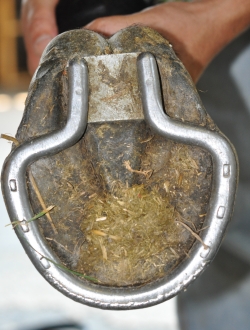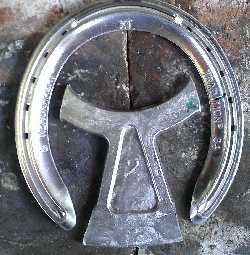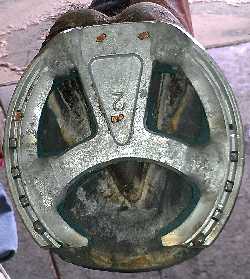While checking Swan In A Million’s heels using a hoof tester, we found him to be extremely sensitive in all four heels of both front feet. The mushroom shoe was indicative that the previous trainer and farrier were trying to help Swan In A Million with this situation.In the summer of 2011, trainer Bob Stewart picked up a horse named Swan In A Million. The colt trotter had a mushroom shoe on at the time to alleviate some of the heel pain that he was showing in both front feet.
Swan In A Million also had another underlying issue – his hooves had distorted forward enough to cause issues with his coffin joints. Mushroom shoes take pressure off of both heels very effectively, but unfortunately, it doesn’t take long before the frog of the hoof is compromised too much to help anymore with the heel pain. Without sharing the load with the hoof wall, over time the frog will be reduced to a level at or below the ground surface of the hoof wall, rendering it ineffective because the heels are once again hitting the ground. (Picture 1)
This can compound problems with coffin and ankle joints because those joints are under the least stress when the three pastern bones are in good alignment with each other. Basically, this means that the hoof and pastern are on the same plane angle. If the frog plate of a mushroom shoe becomes lower than the hoof wall in the heel area, it effectively becomes a reverse wedge. This will lower the hoof angle and increase pressure on the coffin joint at the moment of breakover if the lower hoof angle takes those bones out of correct alignment.
 Mushroom Shoe
Mushroom Shoe
One cannot lay blame on the previous stable and farrier knowing that they were trying to help the main issue of heel pain by using a mushroom shoe. Also, we didn’t know how long those shoes had been on, which is a key factor. To judge a shoeing job four to six weeks after it was done can often be unjust.
Since hoof and coffin joint pain can, over time, cause secondary lameness, it was decided to turn him out for a break. While Swan In A Million was training back to race, we shod him pretty normally. We used a 9/16 half-round shoe and an aluminum circuit plate to help with the heel pain.
Swan In A Million trained down well in the Stewart Stable and shipped to New Jersey with the rest of the horses Bob trains in mid spring. Once racing, Swan In A Million again began to have heel pain issues. Bob called me and said Pascal Harbors, a farrier in Jersey, suggested a combi shoe (Picture 2), with pads. Pascal removed the full pad only in the toe and over the inside (medial) heels, which were the most sore.
 Combi Shoe
Combi Shoe
Swan In A Million responded well and raced very good for a month. After he got back to Lexington, his heels were again very tender and it was starting to affect his racing performance. The combi shoes did a nice job getting him going again, but didn’t sustain him long-term.
We took his shoes off for four or five days while the veterinarian—who was also Bob’s wife--took measures to get the soreness out of his feet. We shod him back with a modified mushroom shoe that kept a thin plate over the heels, but kept normal thickness on the frog in an attempt to get the best effects of both shoes.
Swan In A Million again responded well to the treatment, winning easily in Indiana in 1:54.3. The euphoria of thinking we finally had him figured out was short-lived, and we went back to the combi shoe and pad, this time with an open toe configuration to help ease the resistance of breakover.
Combi shoes with a pad, like anything that covers the entire bottom of the hoof, can actually cause some hooves to widen slightly. When his feet spread out a little bit, I could not bring myself to put the now-too-small shoe back on. I took a different style aluminum shoe and welded the combi part into it (Picture 3). After doing this, I realized the new shoe type allowed me to open the toe more and after doing so noticed the breakover was in better orientation to the pastern angle and the coffin joint. It was the first shoe I felt achieved this on his hoof.
 Aluminum shoe and welded combi part
Aluminum shoe and welded combi part
Swan In A Million won at Indiana Downs in 1:53.3 and the driver thought he was the soundest he had been. In the end, Swan In A Million, like many racehorses, needed a constantly revolving and evolving shoeing prescription. His size and dynamic gait put a lot of stress on those hooves.
The reason changing helps is because we are adjusting load areas of the hoof. As we relieve one area, another has to take more of the burden. And so starts the vicious cycle, and the frustration of figuring out what helps and when. It makes one appreciate the horse that races in the same shoe for an entire career, which is far rarer than the case described here.
It doesn’t mean that we become “mad scientist” in the blacksmith shop. We sometimes spend more time thinking than shoeing. It is a good feeling when the ideas work, and you find that great fit.
Veteran Standardbred farrier Steve Stanley of Lexington, Ky., authors a monthly column for Hoof Beats, the official harness racing publication of the U.S. Trotting Association. The American Farriers Journal Editorial Advisory Board member offers plenty of practical advice that will be of special interest regardless of the type of horses that you work with. Click here to read more from Steve Stanley's Hoof Beats series.








Post a comment
Report Abusive Comment